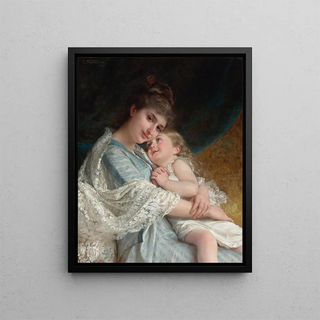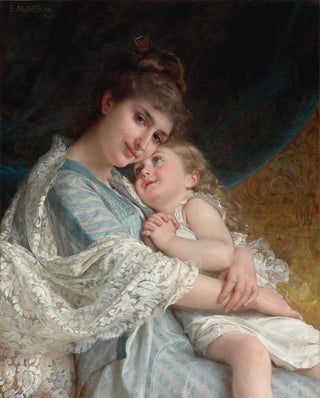Art print | A tender embrace - Émile Munier


View from behind

Frame (optional)
In the world of art, some works manage to capture the very essence of human emotions. "A Tender Embrace" by Émile Munier is one of those creations that transcends time and space. This painting, imbued with softness and passion, evokes a palpable intimacy between its subjects, a connection that seems to vibrate beyond the canvas. Immersing oneself in this visual universe, the viewer is immediately transported to a suspended moment, where tenderness and love intertwine in a delicate dance. Munier's technical mastery, combined with his keen sense of visual storytelling, invites deep contemplation and reflection on the nature of human relationships.
Style and uniqueness of the work
Émile Munier's style is characterized by striking realism, where every detail is meticulously crafted. In "A Tender Embrace," the faces of the two protagonists are rendered with such precision that they almost seem alive, breathing emotion. The chosen colors, soft and harmonious, reinforce this intimate atmosphere, while light plays a fundamental role in staging the characters. Delicate shadows and subtle reflections create a warm ambiance, enveloping the figures in a halo of tenderness. The work also stands out for its balanced composition, where flowing lines and gentle curves guide the viewer's gaze toward the heart of the scene. Every element is designed to evoke a sense of closeness and human warmth, making this painting a true masterpiece of emotion.
The artist and his influence
Émile Munier, born in 1840, was a French painter whose talent established itself within the academic movement. His rigorous training and meticulous observation of human nature allowed him to develop a unique style, combining impeccable technique and sensitivity. Munier captured moments of life with rare intensity, and his work influenced many contemporary artists. Exploring themes of love, family, and intimacy, he contributed to enriching the artistic heritage of his time. "A Tender Embrace" exemplifies his ability to translate complex emotions

Matte finish

View from behind

Frame (optional)
In the world of art, some works manage to capture the very essence of human emotions. "A Tender Embrace" by Émile Munier is one of those creations that transcends time and space. This painting, imbued with softness and passion, evokes a palpable intimacy between its subjects, a connection that seems to vibrate beyond the canvas. Immersing oneself in this visual universe, the viewer is immediately transported to a suspended moment, where tenderness and love intertwine in a delicate dance. Munier's technical mastery, combined with his keen sense of visual storytelling, invites deep contemplation and reflection on the nature of human relationships.
Style and uniqueness of the work
Émile Munier's style is characterized by striking realism, where every detail is meticulously crafted. In "A Tender Embrace," the faces of the two protagonists are rendered with such precision that they almost seem alive, breathing emotion. The chosen colors, soft and harmonious, reinforce this intimate atmosphere, while light plays a fundamental role in staging the characters. Delicate shadows and subtle reflections create a warm ambiance, enveloping the figures in a halo of tenderness. The work also stands out for its balanced composition, where flowing lines and gentle curves guide the viewer's gaze toward the heart of the scene. Every element is designed to evoke a sense of closeness and human warmth, making this painting a true masterpiece of emotion.
The artist and his influence
Émile Munier, born in 1840, was a French painter whose talent established itself within the academic movement. His rigorous training and meticulous observation of human nature allowed him to develop a unique style, combining impeccable technique and sensitivity. Munier captured moments of life with rare intensity, and his work influenced many contemporary artists. Exploring themes of love, family, and intimacy, he contributed to enriching the artistic heritage of his time. "A Tender Embrace" exemplifies his ability to translate complex emotions






